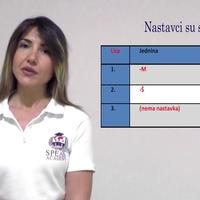Lesson 3.2 Part II Serbian Language - How to Build PRESENT
|||||||строить (1)|настоящее время
|||||how||Build|present
|||||Як||Будувати|теперішній час
Lektion 3.2 Teil II Serbische Sprache – Wie man PRESENT aufbaut
Μάθημα 3.2 Μέρος II Σερβική Γλώσσα - Πώς να δημιουργήσετε το ΠΑΡΟΝ
Lesson 3.2 Part II Serbian Language - How to Build PRESENT
Lección 3.2 Parte II Idioma serbio: cómo construir PRESENTE
Leçon 3.2 Partie II Langue serbe - Comment construire le PRÉSENT
Lezione 3.2 Parte II Lingua serba - Come costruire PRESENT
Урок 3.2 Часть II Сербский язык – Как построить настоящее время
Ders 3.2 Kısım II Sırp Dili - PRESENT Nasıl Oluşturulur
课 3.2 第二部分 塞尔维亚语 - 如何构建现在时
PREZENT
презент (1)
Présent
present
подарунок
Sad je vreme da naučimo kako se gradi prezent.
||||учимся|||строится|
Now||time||learn|||builds|present tense
Сумно||||вивчимо як|||будується презент|
Jetzt ist es an der Zeit zu lernen, wie man ein Geschenk bastelt.
Now is the time to learn how the present tense is formed.
U srpskom jeziku prezent se gradi od prezentske osnove i nastavaka (prezentska osnova + nastavci).
|||||||основы настоящего времени|||суффиксов|основа настоящего||суффиксы
||||||||base verbale||terminaisons|||
|||||||present tense|base||endings|present|base|endings (1)
|||||||теперішній|основа||закінчень|презентна|основа|закінчення дієслів
||||||||grundlag|||||
In the Serbian language, the present tense is formed from the present stem and endings (present stem + endings).
Prezentsku osnovu dobijamo tako što od prvog lica množine prezenta odbijemo nastavak –mo, recimo ako imamo glagol trčati:
||получаем|||||||настоящее время|отбрасываем|окончание|мы|||||
|base du présent|obtenons|||||personne||||terminaison||||||
present|basis|we get|"by"|||first|first person plural|plural|present|we remove|ending|we|for example|if|we have|verb|"to run"
Презентну|основу|отримуємо|||||||презент|відкидаємо||мої|наприклад||||бігти
||||||||flertallet|præsentum||||||||
The present stem is obtained by removing the ending -mo from the first person plural of the present tense, for example, if we have the verb to run:
Mi trčimo
|мы бегаем
|we run
|бігаємо
We are running
Mi trčimo
|run
We are running
Osnova je trči-.
||бегать
La base||
||run
||бігти
The basis is run-.
Njoj dodajemo nastavke.
ей|добавляем ей|окончания
À elle|Nous ajoutons|extensions
To it|we add|suffixes
їй|додаємо|додатки
We are adding sequels to it.
Nastavci su sledeći:
||suivants
The suffixes||next
||наступні
The sequels are as follows:
Oni pričaju.
|speak
|говорять
They are talking.
Oni vuku.
|тянут
|pull
|тягнуть
de|
They pull.
Oni trče.
|они бегут
|are running
|вони бігають
They are running.
Kada se koji od ova tri nastavka upotrebljava, govorićemo u nekoj od narednih lekcija.
||||||||||||следующих|
Quand||lequel||||suffix|utilise|||||prochaines|
||which||||suffix|is used|we will talk||one of||upcoming|lessons
||||||продовження|використовується|говоритимемо||якійсь||наступних|
When each of these three suffixes is used, we will discuss it in one of the upcoming lessons.
Glagol zvati se u prezentu (potvrdni oblik)
|||||утвердительный (1)|форма 1
Verbe s'appeler présent|s'appeler||||affirmatif|forme affirmative
|to call||||affirmative|
|||||підтверджувальний|
The verb 'to be called' in the present (affirmative form)
Glagol imati (prezent, potvrdni oblik)
|||affirmative|form
The verb to have (present, affirmative form)
Da bismo dobili odrični oblik glagola, dodaćemo ispred rečcu ne. Rečca ne piše se odvojeno od glagola.
|чтобы||отрицательный|||добавим||частица|не|||||отдельно||
||obtenu|négatif|||||particule ne||||||séparément||
|we|get|negative|||we will add|in front of|particle||particle||||separately||
||отримали||||додамо||частка не||||||окремо||
|||negativt|||||||||||||
To get the negative form of the verb, we will add the word 'not' in front of it. The word 'not' is written separately from the verb.
Ja se ne zovem Marija. Ja se zovem Aleksandra.
||||Maria||||
||||Марія||||
My name is not Marija. My name is Aleksandra.
Ali, kod glagola imati, rečca ne piše se spojeno sa glagolom.
||||||||слитно||
||||particule ne||||attaché||
|about|verb||||||||verb
|з контекстом|||||||||дієсловом
||||||||sammen||verbet
But, with the verb to have, the word is not written in conjunction with the verb.

